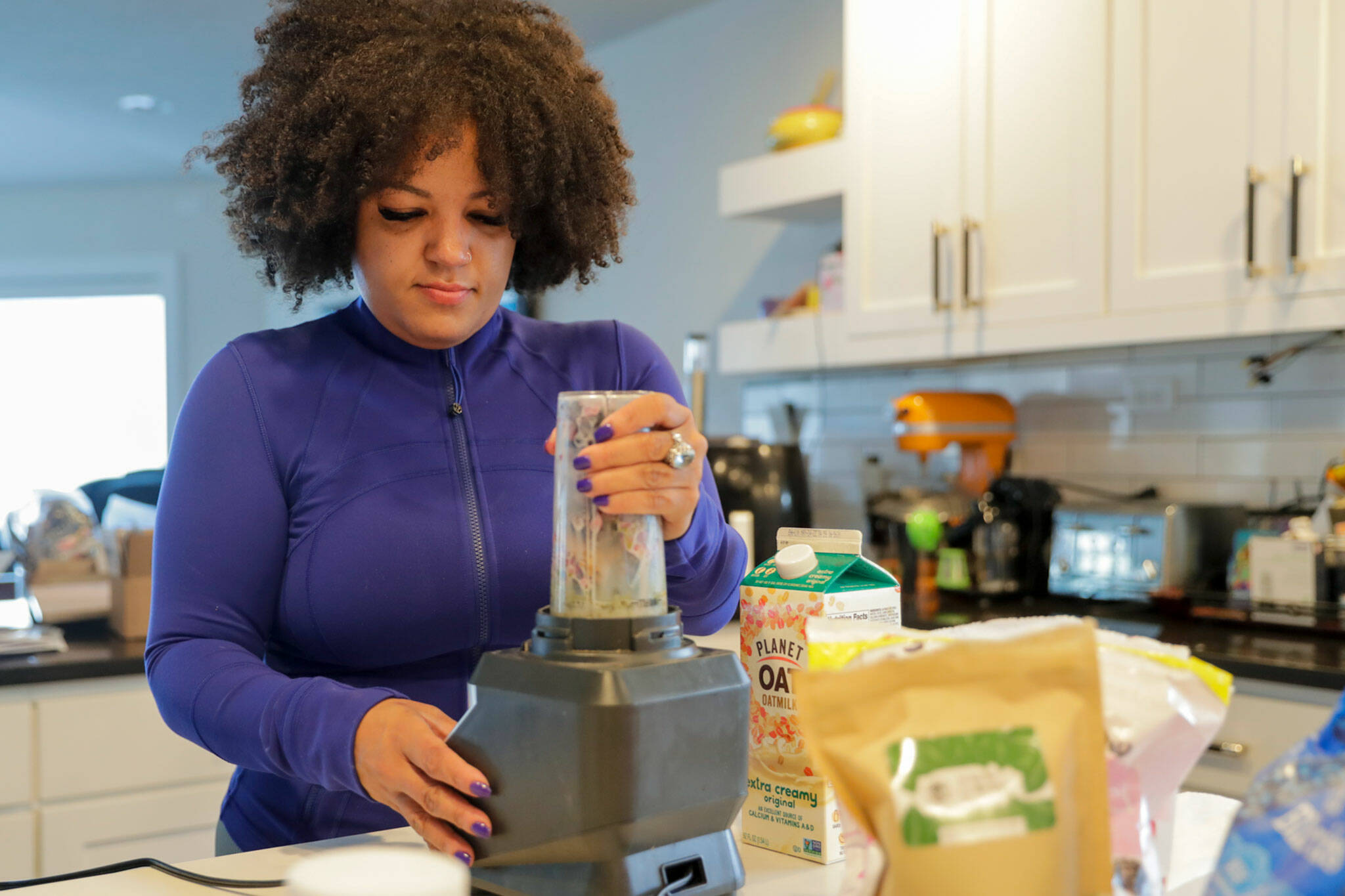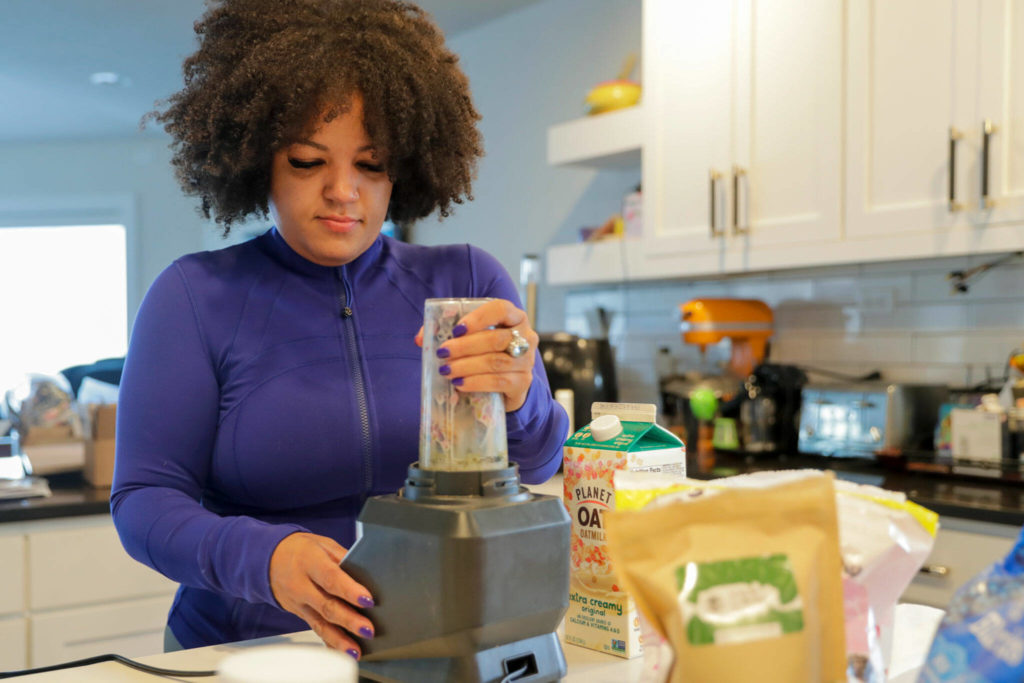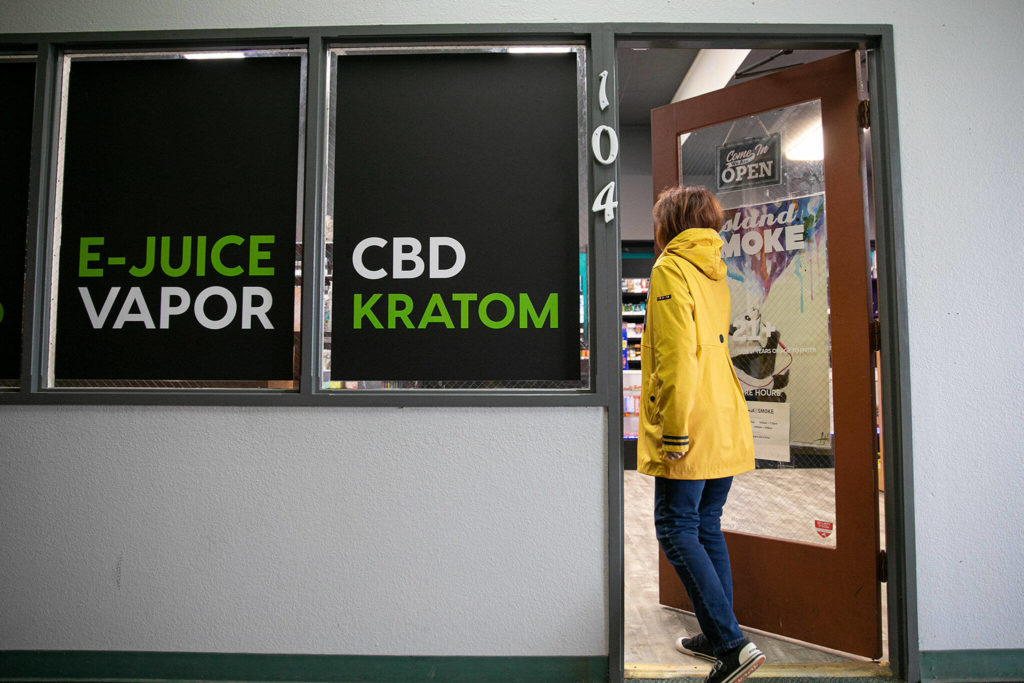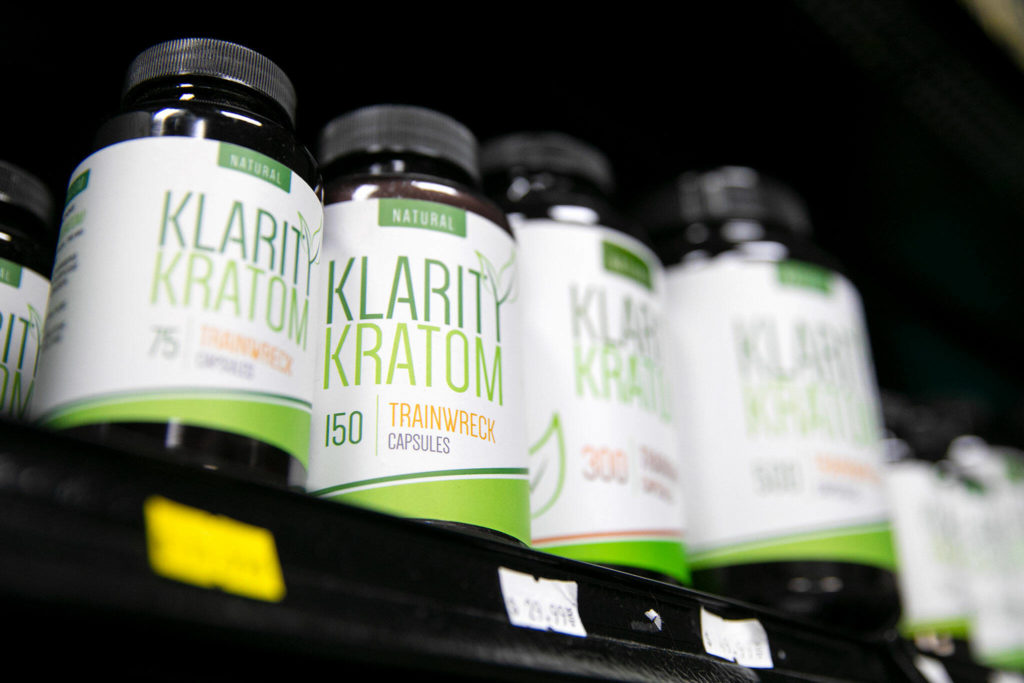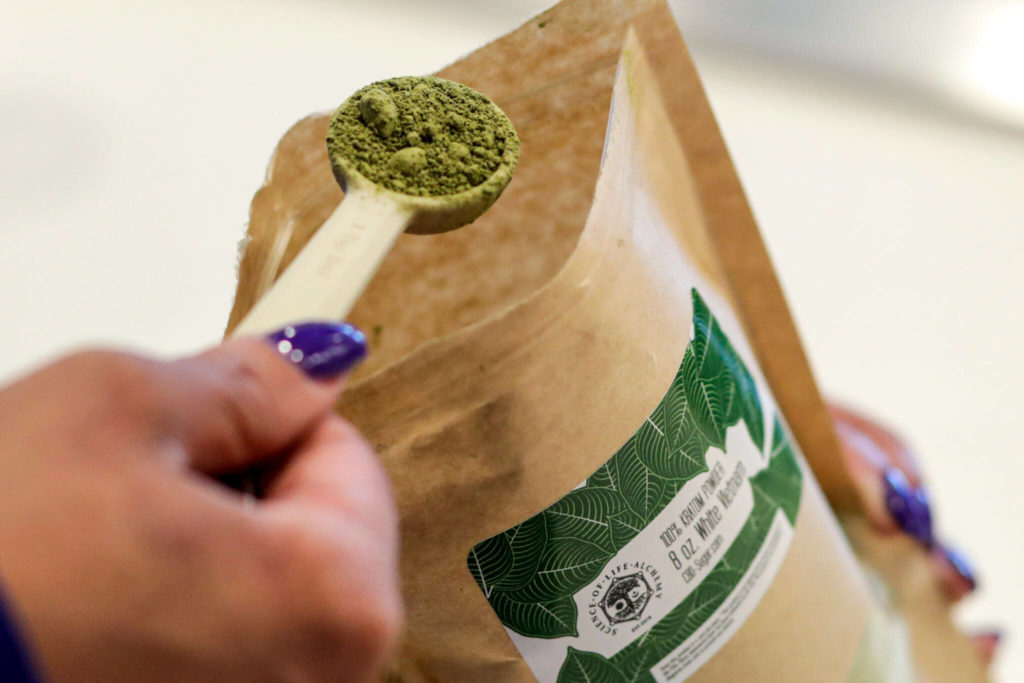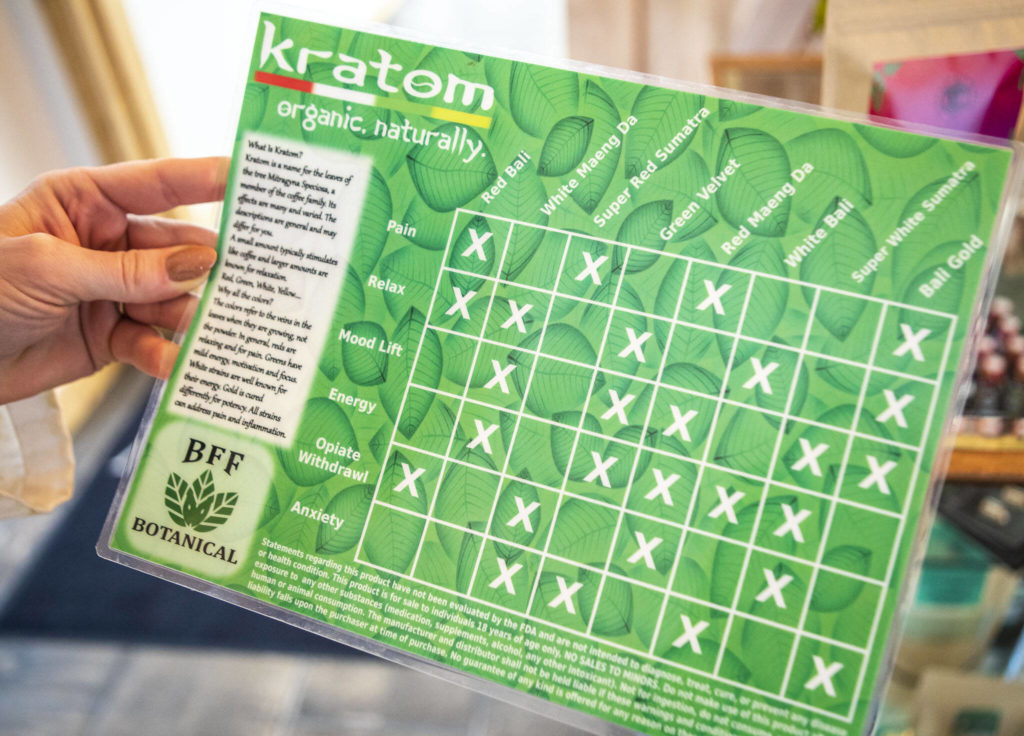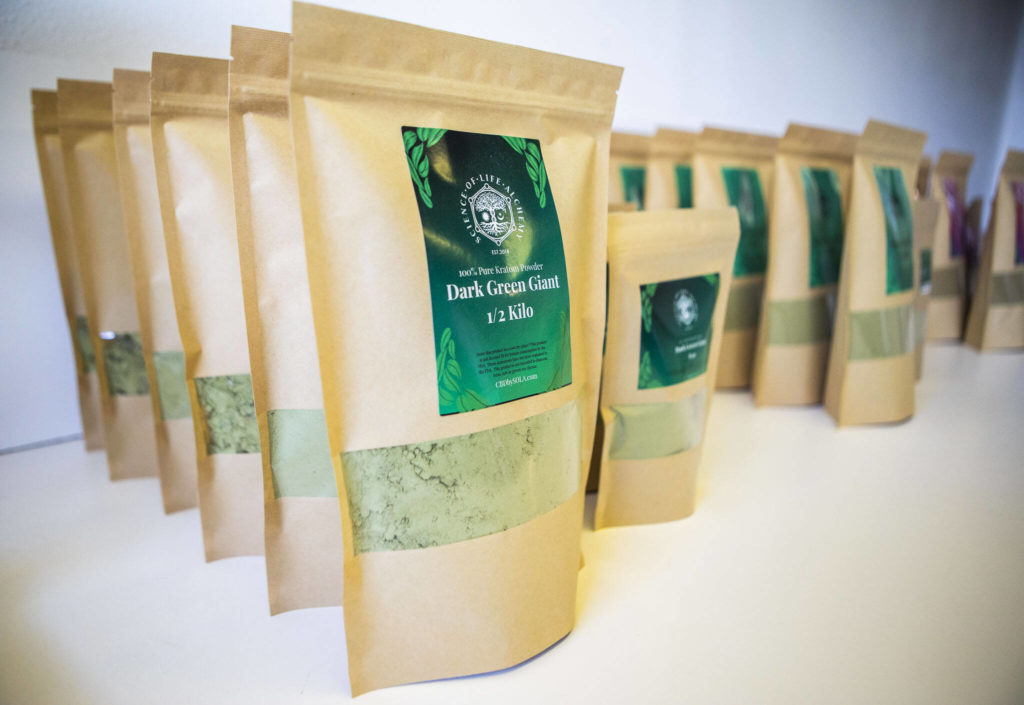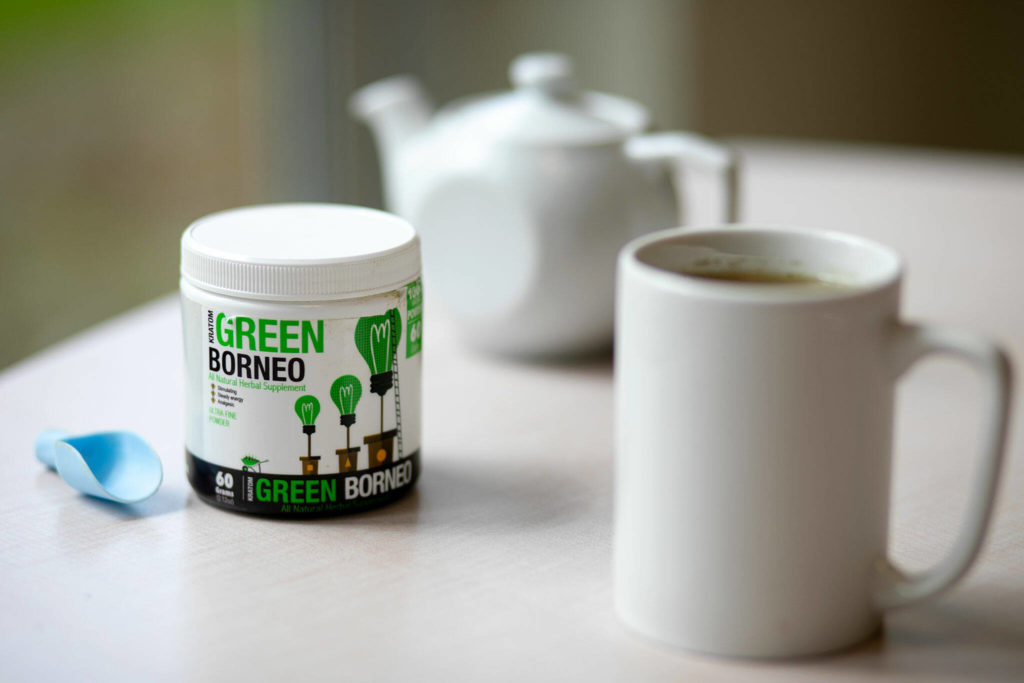EVERETT — The signs have exploded across Snohomish County.
“KRATOM” in big letters, plastered on store windows, lit up in neon. Roadside “Kratom sold here” arrows point across strip mall parking lots.
Dozens of smokeshops and gas stations along Highway 99 and Evergreen Way compete to reel in kratom buyers. “$79 kilos” is the special at a wellness store stocked with kratom, sold here to anyone 18 and older. It’s also easy to buy online, packaged with brands such as Happy Hippo Herbals, Golden Monk and Craving Kratom.
Kratom (pronounced cray-tum), a psychoactive herb from Southeast Asia, is the new drug on the block. It is used for energy, anxiety, pain and opioid withdrawals, yet not FDA-approved for any use.
Health officials warn kratom is addictive and basically unregulated, with serious potential for abuse by people seeking an over-the-counter legal high.
In a county hit hard by the opioid crisis, kratom has seen a surge of interest — mirroring a spike of overdoses from synthetic street drugs such as fentanyl, as people who are self-medicating seek out alternatives to prescription painkillers.
Just how much safer is kratom? It depends on how the drug, marketed as an herbal supplement, is used.
For Rainey Forzetting, 27, it’s her morning coffee.
“It gives me that good boost of energy,” she said.
The kratom buzz is smooth, not jittery, unlike the anxiety she’d get from caffeine.
At her Lake Stevens home, she drinks it cold, blending the bitter powder in a morning smoothie before hitting the road for a long day of sales calls.
Other people drink kratom hot in a tea, swig back a shot of extract or take capsules of the herb that can be harsh on the stomach.
For those with an opiate addiction, the nausea it can cause is a minor inconvenience.
Trying to fight a heroin addiction, Pamela Jones turned to kratom, easily accessible at the corner smoke shop.
“I tried kratom thinking it would help with cravings,” said Jones, 27, of Everett. “I was taking handfuls of pills, morning, noon and night. I was able to function, but I would get so sick, too.”
She went back to using heroin before going through treatment. She has been clean for five years.
‘The Wild West’
Kratom lacks the cloud of vaping, the heady high of cannabis and the relative harmlessness of CBD.
It isn’t a drug that parents tend to warn their kids about — in part because it didn’t become a phenomenon in Western countries until recently.
For centuries the leaves have been chewed or brewed as a pick-me-up, like coffee, in Southeast Asia. The accessibility also led to abuse and dependence from chronic users, with physical and psychological effects such as weight loss, psychosis, “jerky movement of the limbs, watery eyes/nose, hot flushes, fever, decreased appetite, and diarrhea,” according to medical literature.
Coffee and kratom are both members of the family of flowering plants, Rubiaceae, as are over 13,000 other species. Kratom comes from the tree, mitragyna speciosa. The main opioid-like alkaloids, mitragynine and 7-hydroxymitragynine, give it its kick.
For export, the leaves are dried and ground into powder. Most kratom in the United States is imported from Indonesia.
Six states prohibit the use of kratom, which is also illegal in Australia, Denmark, Finland, Israel, Japan and other countries.
According to the lobbying group American Kratom Association, 11 million to 15 million Americans use kratom, up from 3 million to 5 million in 2016.
“It became popular in the United States in the early 1970s when our Vietnam soldiers came home and used it over there,” said C. McClain “Mac” Haddow, a spokesperson for the group.
“When you take the leaf, pluck it from the plant and chew on it, it gives you an energy boost and increases focus. Our soldiers found it helpful during the war during long days of hot jungles.”
Haddow, 71, a former Utah state House member, said he uses kratom for his “old guy aches and pains.”
He was chief of staff at the Department of Health and Human Services until 1987, when he pleaded guilty to funneling over $55,000 in government and private foundation funds into his own pocket. He served three months behind bars.
Haddow ran an election campaign for the late Orrin Hatch, the nation’s longest-serving Republican Senator, who sponsored the Dietary Supplement Health and Education Act in 1994. The act treats supplements more like food, not requiring the same standards as prescription drugs. It boosted the industry of herbal remedies — like kratom.
Since 2016, Haddow has worked with the American Kratom Association to help states establish consumer protection measures to regulate product safety and testing standards.
“It is the Wild West,” Haddow said. “Because it is sold without regulation there are a lot of unscrupulous vendors that adulterate it. They add things like heroin or morphine or fentanyl to it just to give it a spike, so people get addicted to it.”
‘Drug of concern’
Two different bills dealing with kratom use were introduced into the Washington state Senate this year, one to ban it and another to regulate it to benefit consumers. Neither made it past a first reading.
In 2018, the Snohomish Health District called for the state “to take meaningful action to address kratom that could include a ban, age restrictions, research and data collection, and an educational campaign.”
Nothing came of it.
The district hasn’t taken any action since. Health officer Dr. Chris Spitters said efforts “are focused on areas that are of notably higher concern than kratom, such as the rising death toll of the synthetic opioid fentanyl.”
Still, Spitters advises against kratom use.
“In addition to opioid-like effects of respiratory depression, dependence and withdrawal, the frequent and prolonged use of kratom for pain, opioid withdrawal, or recreational use has been associated with seizures, depression, and psychosis,” he said.
The National Institute on Drug Abuse reports that “rare but serious effects have been reported in people who use kratom.” A “very small” number of deaths have been linked to kratom products, with nearly all of them involving other drugs, the institute noted.
The Snohomish County Medical Examiner’s Office reports 14 deaths since 2018 where mitragynine (kratom) was among the substances in their system. In seven cases, fentanyl was in the mix with kratom, and the others had substances such as cocaine, methamphetamine and oxycodone. No deaths were from kratom alone.
A study of 293 regular kratom users in Malaysia showed they “do not seem to experience major impairments in their social functioning, despite being dependent on kratom for prolonged periods. Furthermore, (kratom) use does not imply risky behaviours such as needle sharing, common in heroin dependents.”
Dr. Scott Phillips, medical director of Washington Poison Center, said the center averaged four to six kratom calls a month over the past four years.
The calls are infrequent compared to other substances, he said, such as prescription drugs and over-the-counter pain, cough and cold remedies.
“The real worry is when they start to mix kratom with other medications and alcohol, that’s when we really start to see problems,” Phillips said.
The U.S. Food and Drug Administration unsuccessfully proposed an international ban, citing “substantial concern regarding the safety of kratom, the risk it may pose to public health and its potential for abuse.”
The FDA warns consumers not to use any products labeled as containing kratom, but has no control over sales or marketing.
The Drug Enforcement Administration lists kratom as a “drug of concern.” In 2016, the DEA announced plans to temporarily classify kratom as a Schedule I substance with no accepted medical use and a high potential for abuse. Schedule 1 drugs include heroin, LSD, MDMA and cannabis.
But the federal agency backed down from classifying kratom after backlash from the public, advocate groups and lawmakers. Some argued a total ban on kratom would push many users with chronic pain to other substances, like opioids or alcohol.
‘We don’t know enough’
Meanwhile, kratom is trying to gain a foothold in the feel-good, feel-better market dominated by cannabis and CBD products.
This plant isn’t like those plants.
Kratom’s alkaloids interact with the brain’s opioid receptors. It can have euphoric effects, increasing tolerance and dependence.
“We don’t know enough about it. I wouldn’t say that it’s safe for recreation,” said Dr. Todd Carran, medical director of Substance Use Treatment and Recovery Services at Providence Regional Medical Center Everett. “We see people who want to experiment with kratom and get addicted.”
Carran said kratom “can help with mild pain, because it is an opioid.”
That also makes it addictive.
“I’ve seen people try to wean off heroin and prescription opiates using kratom, and then they just get addicted to kratom, so the whole concept doesn’t work,” Carran said.
The two patients at his center detoxing from kratom in the last year were taking doses of 60 to 100 grams daily, considerably higher than casual users.
“Fentanyl is dominating everything we do right now. It is 1,000 times the story of kratom,” Carran said. “If you’re using fentanyl, you’d have no use for kratom. It’s not nearly enough to do anything for you.”
About 0.7% of people had tried kratom in the United States in the past year, with 10.4% of people with opioid use disorder reporting they had taken kratom, according to a 2021 study in the American Journal of Preventive Medicine.
“Depending on what you read, kratom is a dangerous, addictive drug with no medical utility and severe side effects, including overdose and death, or it is an accessible pathway out of undertreated chronic pain and opiate withdrawal,” reads a blog post from Harvard’s Dr. Peter Grinspoon. “How can the (DEA), medical professionals, and millions of regular kratom users have such divergent views of the same plant?”
It is difficult for people to know what to believe.
Even newspaper sites, including The Daily Herald’s heraldnet.com, have run sponsored content that looks similar to real stories to readers clicking on the headline. Those “advertorials” are written by marketers, not journalists.
“No one can argue the effects kratom offers. It provides everything from pain relief to energy boosts,” a sales pitch begins.
“Do you constantly find yourself staring off into space? The proper kratom amount can help you get a grip on your attention span.”
Dangers are not mentioned in the 2,000-word piece.
“Kratom has opiate-like properties, but it’s not addictive or harmful like opioids are,” the article claims, without citing sources.
Carran and other doctors would disagree.
‘Double-edge sword’
Strains of kratom are by leaf vein color. Red for pain, white for energy, green as a balancer, of sorts. The science is fuzzy and colors overlap.
Most gas stations and smoke shops have color charts for guidance to show customers, who are then on their own to figure out what to buy.
Others will offer advice.
“There are many different strains,” said Robert Ryan, owner of Island Smoke at the Ken’s Korner shopping plaza in Clinton on Whidbey Island. “Some are uppers, some are downers. Some help with back pain, some help with getting off opioids, and some help with energy boost. And some just help with sitting on the couch and zonking out.”
His kratom bestseller is Train Wreck, $19.99 for a bottle of 75 capsules.
“Train Wreck is all the strains rolled into one,” Ryan said. “It combines the energy and the mood boost.”
Buyers must be at least 21, but most are over 30, he said.
Dan Sloy’s Alchemy Health & Wellness CBD shop on Evergreen Way in Everett offers a kilo of kratom for $79.
It is sold in 250 gram bags, so shoppers scoring this deal can choose four different strains.
“Typically a person will take about a gram-and-a-half to 2 grams to start with,” Sloy said, “and then you kind of have to find your own dose, do a little bit and see how it makes you feel.”
The kratom sold in the little glass bottles of high-potency extract shots is targeted for a certain clientele.
“It takes their dope sickness away,” Sloy said. “They are a godsend to these people. I hate how it is portrayed. You aren’t going to overdose. It might make you throw up.”
Kratom’s harshness limits the amount the average user can tolerate without retching.
Lindsey Arrington, founder of Hope Soldiers, a nonprofit that helps people with addiction and mental health struggles, said kratom is like “switching from one drug to another” for some people trying to get sober.
“It’s a double-edged sword,” Arrington said. “You’re not committing a crime, but you have quicker access to it. You can function and you don’t have to get it from a drug dealer or rob anybody to get it. It’s not that type of lifestyle, but that doesn’t mean you are able to progress and heal.”
Pamela Jones said she spent $40 to $200 a week on her kratom habit.
“I’d take two handfuls of pills and eat them, just to feel normal,” Jones said. “I took whatever I could get my hands on. I’d take it throughout the day to keep going.”
Kratom gave her “euphoria, energy and calmness,” she said.
Jones was living in Iowa at the time and going to cosmetology school.
“I was still able to function when I was taking kratom,” she said. “When I didn’t have it, I started having withdrawal symptoms similar to heroin, and I couldn’t function.”
The kratom high was short-lived. Side effects lingered.
“I would get so sick, too. I was down to 100 pounds,” she said. “To get off of it, I started doing opiates again.”
Instead of cycling back to kratom again, Jones later spent two years in a sober living house.
“I’ve changed my life around,” she said.
She now works as a school custodian, is married and recently bought a house in Everett. She’s glad kratom is behind her.
“Everyone I know who takes it is a mess,” Jones said. “Maybe for normal people, it works. I feel like if you are an addict, it is dangerous.”
Herald reporters Caleb Hutton, Ellen Dennis and Zachariah Bryan contributed to this story.
Andrea Brown: 425-339-3443; abrown@heraldnet.com; Twitter: @reporterbrown.
Talk to us
> Give us your news tips.
> Send us a letter to the editor.
> More Herald contact information.
